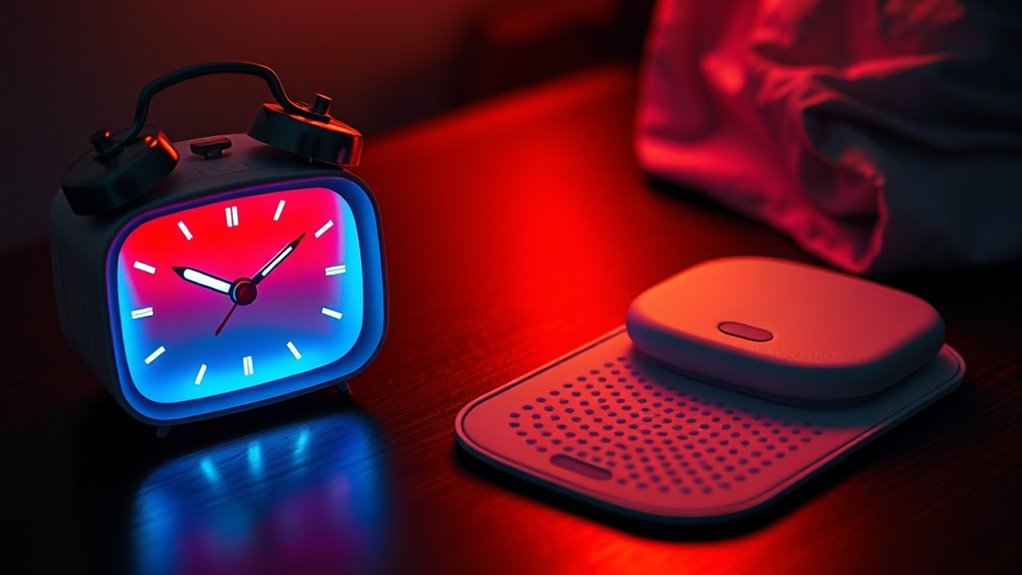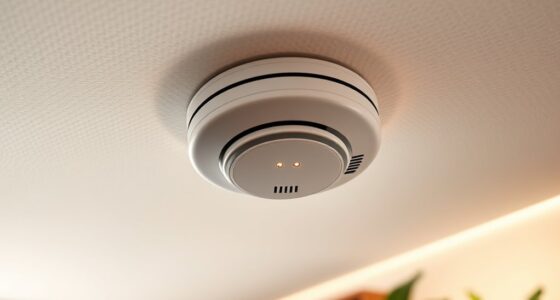Vibration and light both activate different sensory pathways to wake you up effectively. Vibration provides tactile feedback that you can feel even with your eyes closed, making it ideal for heavy sleepers or quiet environments. Light-based alarms mimic natural sunrise with flashing or gradual luminance, helping to gently energize your body. Combining both can boost reliability, ensuring you wake up no matter your sleep stage. Continue to explore how these cues work together for a soundless wake-up solution.
Key Takeaways
- Vibration provides tactile alerts directly on the skin, effective even with eyes closed, ideal for heavy sleepers or noisy environments.
- Light-based alarms activate visual pathways, mimicking natural sunrise, promoting gentle, circadian-aligned awakening.
- Combining vibration and light enhances alarm reliability by engaging multiple sensory channels simultaneously.
- Vibration is discreet and customizable, while light cues can be tailored by brightness and color for personalized waking experiences.
- Multisensory alarms ensure higher wake-up success, especially for those with hearing impairments or in settings where sound is unsuitable.

Have you ever wondered how vibration and light differ in how they influence our environment and perceptions? When it comes to deaf-friendly alarm clocks, understanding these differences can make a huge difference in how effectively you wake up and respond. Vibration and light are both sensory cues, but they engage different parts of your nervous system and serve unique purposes. Vibration provides haptic feedback—touch-based signals that you can feel directly on your skin. This tactile sensation is particularly useful for individuals who can’t rely on auditory cues. When an alarm vibrates, it sends a physical stimulus through a device like a wristband or bed shaker, which then translates into a clear, immediate sensation. This haptic feedback is discreet, customizable, and can be felt even if your eyes are closed or you’re in a noisy environment. It’s especially beneficial for heavy sleepers or for those who need a wake-up method that doesn’t disturb others. Incorporating sound design techniques can enhance the effectiveness of these cues by tailoring the stimuli to individual preferences.
On the other hand, light-based alarms rely on visual cues to alert you. These alarms typically involve bright, flashing lights or gradually increasing luminance that mimic the rising sun. The visual stimulus triggers a response by activating your visual pathways, helping to gently rouse you from sleep. Light-based alarms are effective because they tap into your body’s natural circadian rhythm, encouraging a more natural awakening compared to sudden sounds or vibrations. They can be particularly useful in environments where noise might be disruptive or for individuals who are sensitive to tactile stimuli. Furthermore, visual cues like flashing lights are easily customizable, allowing you to choose the intensity or color that best helps you wake up comfortably.
Both vibration and light cues serve specific roles, and many deaf-friendly alarm clocks combine them to maximize effectiveness. For example, a device might shake your bed while simultaneously flashing a bright light, ensuring that even if you’re a deep sleeper or in a different room, the signals are unmistakable. The key is that these sensory cues work through different channels—haptic feedback engages your sense of touch, while visual cues activate your sight. This multisensory approach ensures you don’t miss your alarm, regardless of your sleep stage or environment. By understanding how vibration and light influence perception, you can choose or customize an alarm that suits your needs best, ensuring a reliable, gentle wake-up every morning without relying on sound.
Frequently Asked Questions
Can Vibration or Light Be Used Together for Better Effectiveness?
Using vibration and light together enhances alarm effectiveness through multimodal synchronization, which combines multiple sensory inputs for better alertness. You’ll find that sensory integration helps wake you more reliably, especially if you’re deaf or hard of hearing. By combining these stimuli, you create a more all-encompassing and dependable wake-up experience, ensuring you don’t miss important cues. This approach maximizes the chances of waking you up promptly and comfortably.
Are Vibration Alarms Safe for Sensitive Skin?
Vibration alarms are generally safe for sensitive skin, but you should be cautious if you have skin irritation or allergy concerns. Some devices might cause discomfort or irritation if they’re too harsh or if you have allergic reactions to materials used. To stay safe, choose alarms made with hypoallergenic materials and test them on a small skin area first. If irritation occurs, stop using it and consult a dermatologist.
How Do Vibration Alarms Compare in Power Consumption?
Vibration alarms are generally more power-efficient than light alarms, which helps extend your device’s battery lifespan. When you use vibration alarms, they consume less energy because they rely on small motors rather than bright, continuous lights. This means your alarm clock stays powered longer between charges, making it a practical choice if you want reliable performance without sacrificing power efficiency or needing frequent battery replacements.
Can These Alarms Be Customized for Different Deafness Levels?
You’re on the right track, as these alarms can be tailored to suit different deafness levels. Many models offer various customization options, like adjustable vibration intensity or light brightness. By customizing settings, you get an alarm that truly wakes you up—no need to rely on a one-size-fits-all approach. It’s like hitting two birds with one stone, ensuring your alarm system matches your specific needs perfectly.
Are There Any Health Risks Associated With Prolonged Use?
You might wonder if prolonged exposure to deaf-friendly alarm clocks poses health concerns. Generally, these alarms are safe because they use non-invasive methods like vibrations or lights. However, extended use of bright lights could disrupt your sleep patterns or cause eye strain, and continuous vibrations might cause discomfort or fatigue. To avoid health risks, use the alarms as intended and take regular breaks from their exposure.
Conclusion
So, which will wake you first—vibration or light? The answer isn’t as simple as it seems. Both have their secrets, their surprises that could transform your mornings forever. Are you ready to discover the ultimate deaf-friendly alarm? The choice is in your hands, but the true breakthrough might just be lurking where you least expect. Stay tuned—what comes next could change how you wake up forever. The future of waking up is closer than you think.











